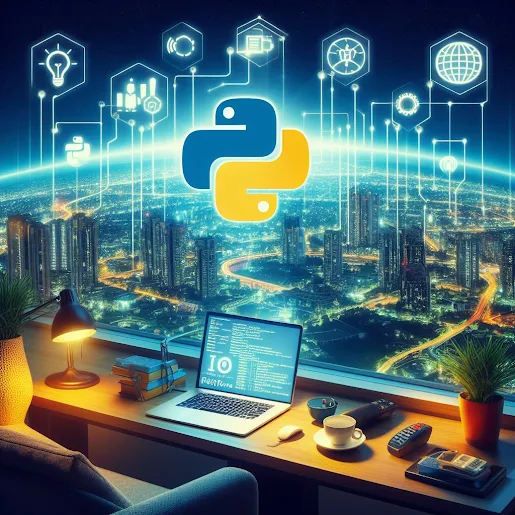Python and IoT: Building Smart Devices for a Connected World
- Get link
- X
- Other Apps
Python and IoT: Building Smart Devices for a Connected World
The Internet of Things (IoT) represents a fascinating phase of the digital revolution, connecting everyday objects to networks, enabling them to collect and exchange data. With the rise of IoT, Python has emerged as a favored language for developing these smart devices. Its simplicity, flexibility, and robust ecosystem make it an ideal choice for IoT projects. In this blog post, we’ll explore how Python is used in IoT and highlight some key considerations for building smart devices.
Why Python for IoT?
Python’s popularity in the IoT realm can be attributed to several factors:
Ease of Use: Python’s simple syntax and readability make it accessible to developers from various backgrounds, including those new to programming.
Versatility: Python's extensive libraries and frameworks cater to a wide range of applications, from data analysis to networking.
Platform Independence: Python can run on various platforms, which is crucial for IoT devices that span different architectures.
Strong Community Support: A vibrant community ensures abundant resources, tools, and libraries specifically tailored for IoT.
Applications of Python in IoT
Python's application in IoT is diverse, encompassing areas like:
- Home Automation: Developing smart home devices like thermostats, lighting systems, and security cameras.
- Agriculture: Creating smart farming solutions with sensors to monitor crop conditions and automate irrigation.
- Healthcare: Building health monitoring devices and wearable tech for patient care.
- Industrial Automation: Implementing systems for monitoring and optimizing industrial processes.
Building Smart Devices with Python
1. Choosing the Right Hardware
Python is compatible with various IoT boards and microcontrollers, including Raspberry Pi, Arduino, and ESP8266. The choice depends on factors like processing power, connectivity options, and energy consumption.
2. Utilizing Python Libraries and Frameworks
Python offers a range of libraries for IoT projects, such as:
- GPIO Libraries: For interacting with the hardware’s General Purpose Input/Output (GPIO) pins.
- Networking Libraries: For connecting devices to the internet and enabling communication between them.
- Data Processing Libraries: To handle and analyze data collected by sensors.
3. Connectivity and Communication
IoT devices often communicate via protocols like MQTT (Message Queuing Telemetry Transport) and CoAP (Constrained Application Protocol). Python supports these protocols, enabling devices to send and receive data efficiently.
4. Data Handling and Analysis
IoT devices generate vast amounts of data. Python’s data handling and analysis capabilities, backed by libraries like Pandas and NumPy, are instrumental in processing this data.
5. Security Considerations
Security is a critical concern in IoT. Python’s robust encryption libraries help in implementing security features like secure data transmission and authentication.
6. Creating User Interfaces
For IoT devices requiring user interaction, Python offers libraries like Tkinter and PyQt to create graphical user interfaces.
A Practical Example: Building a Smart Thermostat
Let’s consider a simple example of creating a smart thermostat using Python and a Raspberry Pi.
- Hardware Required: Raspberry Pi, temperature sensor (like the DHT22), and basic peripherals for setup.
- Software: Python scripts to read temperature data from the sensor and control heating or cooling systems.
- Process:
- Setup the Sensor: Connect the temperature sensor to the Raspberry Pi and use a Python library (like Adafruit_DHT) to read the data.
- Data Processing: Write a Python script to process the temperature data and decide when to turn on/off the heating or cooling system.
- Connectivity: Implement MQTT to send temperature data to a central server or a mobile app for remote monitoring and control.
- User Interface: Develop a simple UI using a Python library for local control and monitoring.
Challenges and Best Practices
- Power Management: IoT devices often run on batteries. Efficient power management is crucial, which can be addressed by optimizing Python code and choosing low-power hardware.
- Scalability: As IoT networks grow, ensuring the scalability of the system is essential. Opt for modular and scalable architecture in your Python code.
- Testing and Deployment: Thoroughly test the device in various real-world scenarios. Python’s testing frameworks can be used for this purpose.
Conclusion
Python's role in the IoT ecosystem is undeniably significant, providing a gateway for developers to innovate and build smart, connected devices. Its simplicity, combined with powerful features, opens up endless possibilities in the IoT space. Whether you're building smart home gadgets, industrial monitors, or health tracking devices, Python stands out as a versatile, efficient, and accessible tool in the IoT developer's toolkit. As IoT continues to evolve, Python is poised to remain at the forefront, driving innovation and connectivity in our increasingly digital world.
- Get link
- X
- Other Apps





Comments
Post a Comment